My Favorite Rhododendrons in our Garden
- vendiolaads
- Jul 5, 2022
- 9 min read
Rhododendrons have many great things going for them. They’re beautiful evergreens. They sport big clusters of blooms. They carry nice, shiny, substantial green leaves. They’re easy to care for. They have hardly any pests and diseases to worry about. They grow neither too fast nor too slow, too big nor too small. Just perfect, almost perfect.
Now, add their vast varieties and the big range in the colors of their flowers, rhododendrons are then almost the perfect garden plant. So in this garden blog story, I’ll share a bit of a history of my love affair with these almost perfect bloomers.
My introduction to rhododendrons came by accident. It wasn’t love at first sight at all.
The homes of my parents-in-law where my young wife and I lived during the first few years of our marriage all had rhododendrons in the yard. The first house had giant rhododendrons towering over me (so they must be at least 6 feet tall) since the house was built in the ’40s; the second house was less than ten years, so the rhododendrons in the yard were much younger and smaller; the third house was newly built, so the rhododendrons were all newly-planted young shrubs.
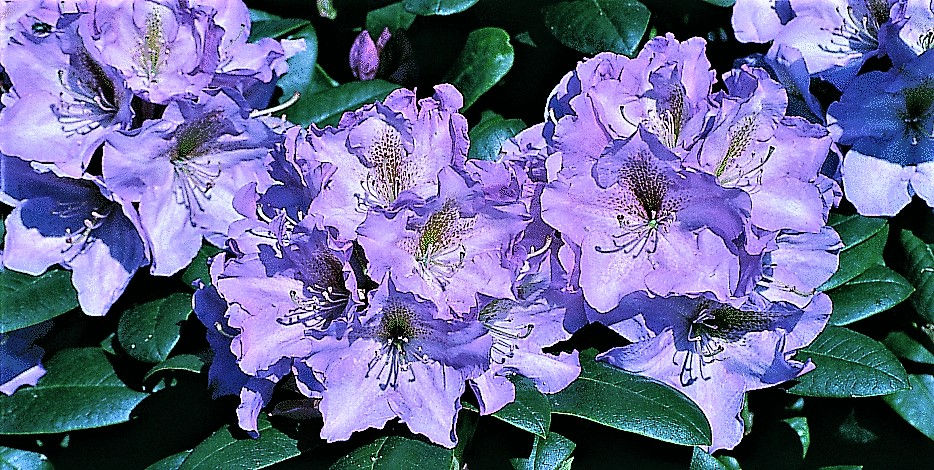
Rhododendron ‘Lavender Princess’
So, I already knew the potential size of rhododendrons, and how small they could start out. Like a David turning into a Goliath, sort of.
I wasn’t really interested in gardening during those years, so my relationship with these plants was lukewarm at best. I appreciated them when they bloomed. That’s it.
During their non-blooming months, the rhododendrons were merely part of the landscape, nothing special or begging for my attention. They were simply one of those many plants in the properties planted either by previous owners or the homebuilders.
So, if you are not into gardening, I wouldn’t be surprised that you’d think nothing special about rhododendrons. Understandable enough.
I warmed up to gardening when we finally got our own home. It was a townhouse we got with the financial help from my very generous parents-in-law; I think it’s because my wife was their youngest and doted upon daughter and I was the least financially capable of their three sons-in-law when I first immigrated to Canada from the Philippines. My wife kept telling me I was her dad’s favorite and my wife got jealous because her mom treated me more nicely than her especially when my wife and I had big young couple's fights during the first years of our marriage.
The townhouse had a very tiny front garden. Postage stamp-sized, most people would call it, a mere couple of square meters.
The previous owners were avid and retired gardeners, and they jampacked climbing roses, clematis, a few other flowering plants and herbs in that tiny space. And of course, a rhododendron ‘Lavender Princess.’ In fact, the selling point of that townhouse was its garden, I thought.
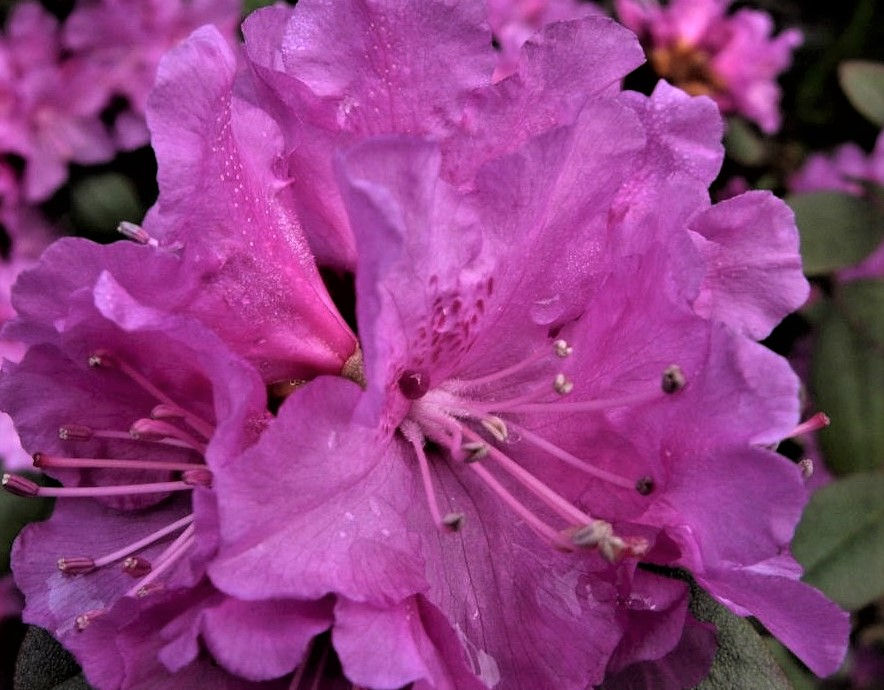
pink rose rhododendron
My wife and I were forced to embrace gardening, maintaining what the previous owners had left for us. We had to keep our garden looking decent because some of our neighbors had kept their postage-stamp-sized gardens overflowing with blooming plants and productive vegetables. Envy and shame, then pride, had a way of turning us into reluctant gardeners.
Later, when we had our second child we also acquired our second and present house, with a much larger lot. We transferred many of our plants from our old townhouse to our present property: clematis, offshoots of the climbing red roses, some herbs, hydrangea, boxwood, irises, azaleas, dahlias, and of course, the Rhododendron ‘Lavender Princess.’
Then our love for rhododendrons slowly blossomed. We sited our transplanted Rhododendron ‘Lavender Princess’ right by our front entrance walkway. For a while, that was the lone plant in our large front yard which at that time was an expanse of grassy lawn.
We expanded bit by bit our flower garden to the sides and the back of the house. To see this special Rhododendron ‘Lavender Princess’ more, we transplanted it to our side garden by our back deck where we would spend most of our free time. Over the years, we planted many perennials and more rhododendrons.
We’re off to owning a real garden.

A NEIGHBOR’S REJECT IS OUR TREASURE: This fuchsia pink rhododendron was salvaged from our back neighbor’s garbage. This is now one of the biggest rhododendrons in our side garden.
Each of our rhododendrons has a story to tell.
One rhododendron came to us from the garbage. The neighbors behind our property threw away a mature shrub. We very quickly salvaged the poor thing. It became part of our growing rhododendron collection.
Another rhododendron was almost a cast-off, perhaps an orphan from a rich family called Art Knapp’s Nursery. We brought home Rhododendron ‘Lemon Dream’ on discount from that nursery. It looked very sickly, hence on sale, but had bounced back nicely. It’s one of the dwarf varieties, with yellow-green flower trusses. The yellow-green flowers don’t get easily noticed.
This rhododendron does not occupy much space though it required a lot of my tender loving care. It’s a keeper for its evergreen roundish foliage. Honestly, I had to keep it for sentimental value, since I poured so much TLC to revive it. One treasures something more for the big love it has required. That’s my Rhododendron ‘Lemon Dream.’
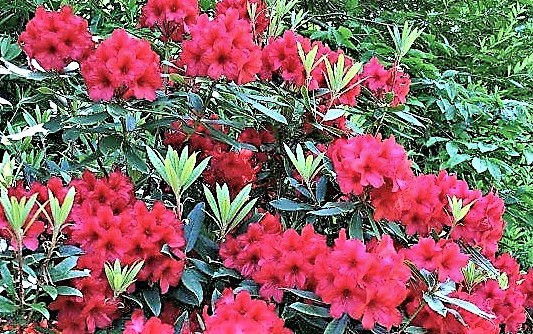
FIRE HYDRANT RED R. ‘Vulcan Flame’ during its glory days near a fire hydrant. We were ordered by the city to remove the rhododendron, and since its transfer, this rhododendron has not flowered well.
We planted a fire-hydrant red Rhododendron ‘Vulcan Flame’ in our corner garden to hide an actual fire hydrant. But the city sent us a letter to remove the rhododendron so the fire hydrant can be easily seen by the firemen and the city maintenance staff in an emergency. We didn’t want to be fined, so we reluctantly transplanted this rhododendron.
The Rhododendron ‘Vulcan Flame’ is now with the rest of our rhododendron collection underneath our neighbor’s giant pine tree. Rhododendrons love acidic soil, with a pH between 4.5 and 6, and the pine needles and cones add to the acidity of the soil, so we thought that rhododendron would love it there. Unfortunately, it hasn’t been doing very well in its new location, giving only very few of its fire hydrant red clusters. Napikon dagay.
Rhododendrons come in more varieties than we imagined. As a part of the Family Ericaceae, there are over 800 stable species in the Genus Rhododendron and over 35,000 hybrids. Those staggering numbers speak well of the versatility and the desirability of rhododendrons.
We learned that the word “rhododendron” comes from two Ancient Greek words: “rhodon,” which means rose, and “dendron,” which means tree. Yet most rhododendrons I’ve seen are just shrubs, not trees, despite the name “dendron.”
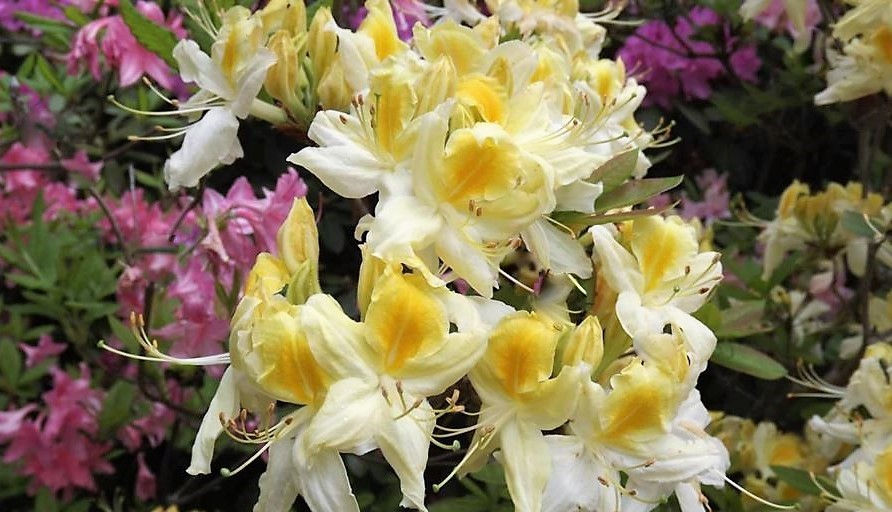
FRAGRANT Rhododendron Northern Hi-Lights is one of the few deciduous rhododendrons.
They could either be evergreen or deciduous. They also include the smaller shrubs we call azaleas. I can tell true rhododendrons because they have ten stamens in a flower whereas azaleas have only five. Stamens are those whisker-like male reproductive parts of the flower. The stamens carry pollen around their knobby ends.
Much hybridization has resulted in a great number of hybrid cultivars. Of note to gardeners in cool temperate areas are the large and small-leaved evergreen rhododendrons and the evergreen and deciduous azaleas. But in general, rhododendrons have larger leaves, larger flowers, and grow taller than azaleas, at least in our garden. Also, rhododendrons prefer shady areas while our azaleas can grow nicely in full sun to part shade.
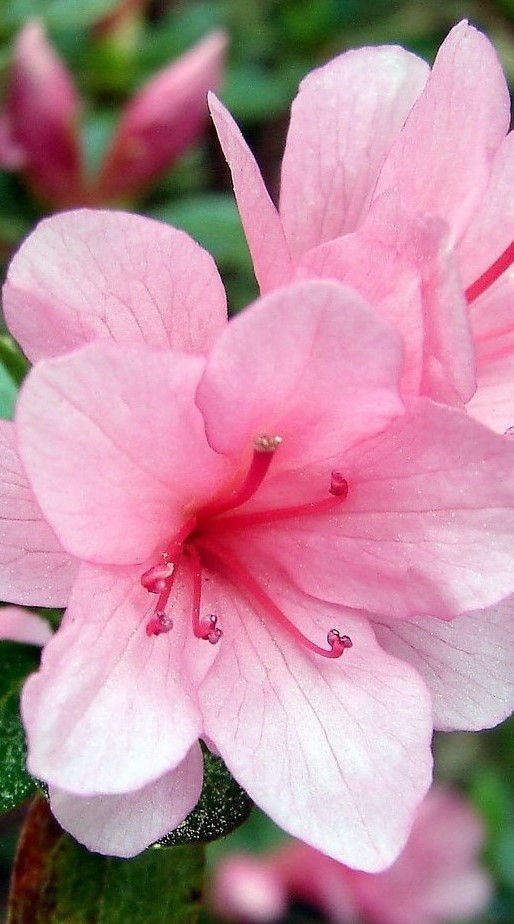
Rhododendrons often have evergreen larger leaves and the flowers have 10 stamens (those “whiskers” coming from the center), while azaleas have smaller leaves and flowers have 5 stamens only. Azaleas can be evergreen or deciduous.
In our garden, we have several dozens of rhododendrons and maybe a dozen azaleas, not substantial but a collection nonetheless. Each rhododendron is different from the others, except those that we loaded in our van from nearby home building supplies stores that were liquidating their left-over plants at the end of the planting season. We’re suckers for plant sales. Cheap is good. Free is best.
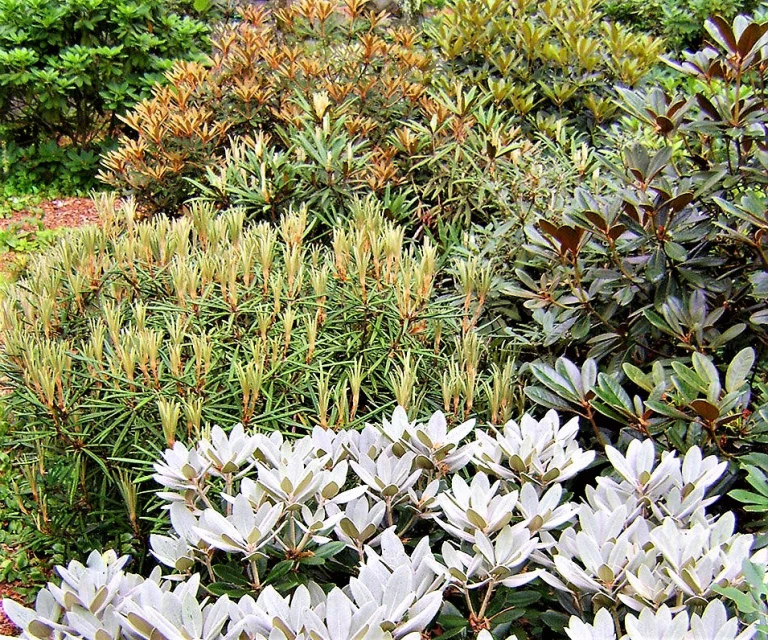
VARIETY OF RHODO FOLIAGE: Rhododendron ‘Vulcan Silver,’ in the foreground, has silver-grey young leaves.
The foliage of rhododendrons also shows variety in size, shape, color, and texture. One of our favorite rhododendrons is Rhododendron ‘Viking Silver,’ with young leaves that have powdery silver grey dusting, turning into glossy dark green when mature. The young leaves tempt us to touch them.
Different rhododendron collectors vary in their top choices. But in many cases, the rugged Rhododendron ‘PJM’ is one desirable variety to have, and has become common in many gardens. (Sorry, we don’t know what PJM stands for, must be the initials of a rhododendron plantsman).
PJM rhododendrons generally grow to 3-6’ tall and are noted for having exceptional winter hardiness. Lavender, rose or pink flowers bloom in clusters of 4-9 flowers per cluster in spring. Most of ours bloom in April to early June, one in August.
Their leaves could be elliptic, hairless, leathery, but mostly dark green to 2.5” long. Foliage acquires purple tones in winter.
These rhododendrons are noted for growing well, and if you’ve seen a rhododendron in your neighborhood, chances are it is one of the many PJM varieties.
We think the best rhododendrons are those that make statements both with their foliage and blooms, those that have unique and big clusters of flowers that never fail to catch our attention, and whose foliage is not only evergreen but structurally or visually unique to stand on its own. We notice that blooms are short-lived — thus, ephemeral — but excellent foliage can give the garden visual magic for those months when blooms are absent.
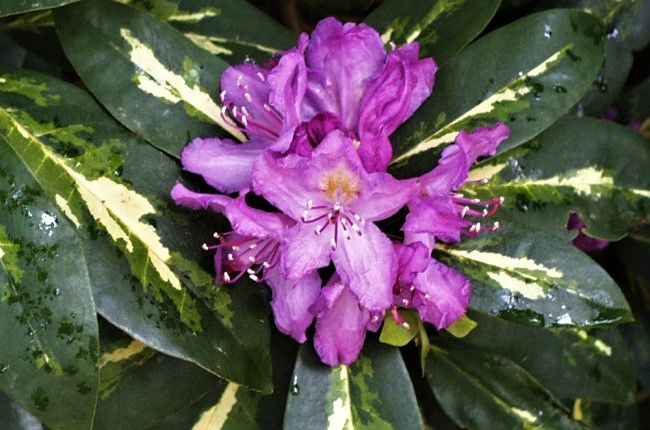
Rhododendron ‘Goldflimmer’: definitely diva of the rhododendrons
We believe such rhododendron is the Rhododendron ‘Goldflimmer,’ one of those few variegated rhododendrons but with painterly splotches like golden stardust that rarely reverts to green. It’s a divine diva of a rhododendron.
But because it’s now highly sought by rhododendron lovers, its stock doesn’t last long on the nursery display stands.
One time, we almost cinched the last pot at a local nursery, but the price tag stopped us in our tracks. The price of the 1-gallon potted Rhododendron ‘Goldflimmer’ was prohibitively far above our budget. To console ourselves, we instead drove off with a 1-gallon pot of Japanese aucuba, with leaves looking just as painterly as the Rhododendron ‘Goldflimmer’ but a price tag 500% lower. Of course, the aucubas don’t bloom, but at least they have nice, red shimmering berries like mini grapes. A ha ha ha, sour graping?
Patience is said to be a gardener’s virtue. We’d say, being money-wise is a greater virtue. So we decided to wait until the price of the Rhododendron ‘Goldflimmer’ will be reasonable in the near future, fingers crossed in a year or two. Our frugality will pay off, we’re sure. It’s a matter of supply and demand in economics, or we hope the demand will bring in so much supply — at a lower price.
We believe that what goes up must come down over time. Or is it true only in Physics, not in economics?
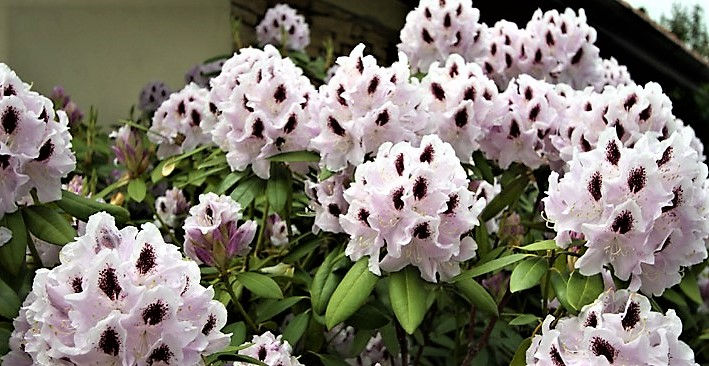
Rhododendron ‘Calsap’ is a stunning bloomer
The Rhododendron ‘Calsap’ is also highly sought. In late spring, its pale lavender buds open to display a pale lavender cluster of flowers that age to drop-gorgeous nearly angelic white petals, emblazoned with a heady wine blotch. It is a heavy bloomer year after year, and its trumpet-shaped blooms exude a slight fragrance when heated by sunlight and cooled in the afternoon.
N.B. We realize rhododendrons don’t like too much water. Moist is good, but soggy, poor-draining soil somehow drowns the fine and shallow roots. Water-clogged soil inhibits gas exchange and stresses rhododendrons, especially the newly planted and young ones, and induces fungal or microbial attack, especially by moist-loving Phytophthora. Too much water drowns these otherwise hardy shrubs.
We notice rhododendrons don’t like to be overfertilized either. According to the American Rhododendron Society, the overwhelming majority of rhododendrons originated from “the slopes of the very deep valleys that border the eastern Himalayas and southeastern Tibet, or in the mountain ranges that form the backbones of the archipelago stretching between mainland Asia and Australia — the islands of Java, Sumatra, Borneo, New Guinea, and the Philippines… over the northern hemisphere, occurring in pockets that, to a considerable degree, are isolated from one another — Japan, northwestern North America, the Appalachian, and the Caucasus Mountains.”
Rhododendrons are used to poor soils, and excessive application of fertilizer merely “burns” the shallow roots. We used to have nutrient-hungry annuals at the feet of one of our rhododendrons by the front garden. We used liquid fertilizers to make the annual bloom more profusely. The annuals did bloom a lot, but our rhododendron looked unhappy with the extra nutrients. We no longer plant annuals around the rhododendron, and the shrub seems to be happier now, sending new shoots after a flush of blooms in late April to early June.
The few shortcomings of rhododendrons, however, are very easily forgiven and overshadowed by the beauty of this garden queen.
Rhododendrons are very popular garden plants, and aficionados hold rhododendron flower shows and contests every year. Many local rhododendron societies in Vancouver, at VanDusen Gardens, in Burnaby, New Westminster, Coquitlam, and many other cities near us hold these much-attended events where prizes are awarded to the best blooms. And rhododendron plant sales and bartering affairs stir frenzied interest among the members and the general public. We drive around to these local rhododendron shows in the hunt for new hybrids and dirt-cheap sample plants.

RHODODENDRON WALK at VanDusen Gardens in Vancouver
Yes, rhododendron is the flowering shrub anyone — gardener or not — should have on their property. If you love big bright splashes of colors in late Spring, with glossy, structural evergreen leaves, try planting rhododendron. And you won’t have to worry about them because they’re almost carefree once established, and surely you won’t be sorry, especially when they are in full bloom.



Comments